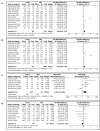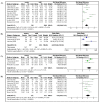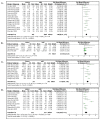Predictors of COVID-19 severity: a systematic review and meta-analysis
- PMID: 33163160
- PMCID: PMC7607482
- DOI: 10.12688/f1000research.26186.2
Predictors of COVID-19 severity: a systematic review and meta-analysis
Abstract
Background: The unpredictability of the progression of coronavirus disease 2019 (COVID-19) may be attributed to the low precision of the tools used to predict the prognosis of this disease. Objective: To identify the predictors associated with poor clinical outcomes in patients with COVID-19. Methods: Relevant articles from PubMed, Embase, Cochrane, and Web of Science were searched as of April 5, 2020. The quality of the included papers was appraised using the Newcastle-Ottawa scale (NOS). Data of interest were collected and evaluated for their compatibility for the meta-analysis. Cumulative calculations to determine the correlation and effect estimates were performed using the Z test. Results: In total, 19 papers recording 1,934 mild and 1,644 severe cases of COVID-19 were included. Based on the initial evaluation, 62 potential risk factors were identified for the meta-analysis. Several comorbidities, including chronic respiratory disease, cardiovascular disease, diabetes mellitus, and hypertension were observed more frequent among patients with severe COVID-19 than with the mild ones. Compared to the mild form, severe COVID-19 was associated with symptoms such as dyspnea, anorexia, fatigue, increased respiratory rate, and high systolic blood pressure. Lower levels of lymphocytes and hemoglobin; elevated levels of leukocytes, aspartate aminotransferase, alanine aminotransferase, blood creatinine, blood urea nitrogen, high-sensitivity troponin, creatine kinase, high-sensitivity C-reactive protein, interleukin 6, D-dimer, ferritin, lactate dehydrogenase, and procalcitonin; and a high erythrocyte sedimentation rate were also associated with severe COVID-19. Conclusion: More than 30 risk factors are associated with a higher risk of severe COVID-19. These may serve as useful baseline parameters in the development of prediction tools for COVID-19 prognosis.
Keywords: COVID-19; SARS-CoV-2; clinical outcome; prognosis; severity.
Copyright: © 2021 Mudatsir M et al.
Conflict of interest statement
No competing interests were disclosed.
Figures









References
Publication types
MeSH terms
Associated data
LinkOut - more resources
Full Text Sources
Other Literature Sources
Medical
Research Materials
Miscellaneous

